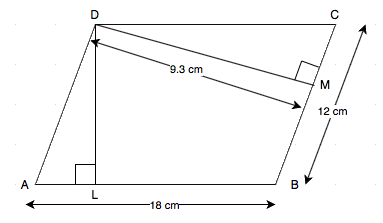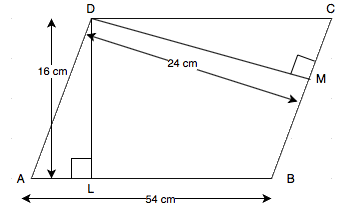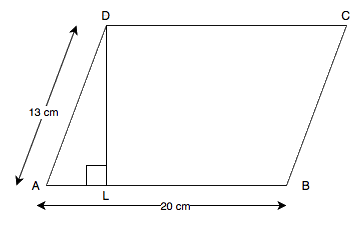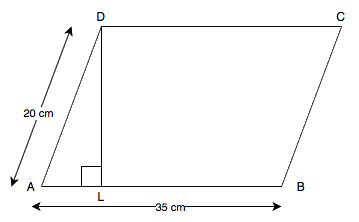Q1. Find the area of a parallelogram with base 8 cm and altitude 4.5 cm.
Sol.Given that Base of the parallelogram = 8 cm.
And altitude of the parallelogram =4.5 cm.
Area of the parallelogram = Base × Altitude
=8 × 4.5 $$ =36 \text { cm}^{2} $$Q2. Find the area in square metres of the parallelogram whose base and altitudes are as under:
(i) Base = 15 dm, altitude =6.4 dm
(ii) Base =1 m 40 cm, altitude =60 cm
Sol. (i) Given that Base of the parallelogram = 15 dm.\begin{array}{l} = 15 \times 10 \text { cm} \quad [\because 1 \text { dm} = 10 \text { cm}] \\ = 15 \times 10 \times \frac {1}{100} \text { m} \quad [\because 1 \text { cm} = \frac {1}{100} \text { m}] \\ = 1.5 \text { m} \\\text {And altitude of the parallelogram}= 6.4 \text { dm} \\ = 6.4 \times 10 \text { cm} \quad [\because 1 \text { dm} = 10 \text { cm}] \\ = 6.4 \times 10 \times \frac {1}{100} \text { m} \quad [\because 1 \text { cm} = \frac {1}{100} \text { m}] \\ = 0.64 \text { m} \\ \text {Area of the parallelogram } = \text {Base} \times \text {Altitude} \\ =1.5 \times 0.64 \text { m}^{2} \\ =0.96 \text { m}^{2} \\ \\\text {(ii) Given that Base of the parallelogram}= 1 \text { m } 40 \text { cm} \\ = 1 \text { m} + 40 \times \frac {1}{100} \text { m} \quad [\because 1 \text { cm} = \frac {1}{100} \text { m}] \\ = 1 + 0.4 \text { m} \\ = 1.4 \text { m} \\\text {And altitude of the parallelogram}= 60 \text { cm} \\ =60 \times \frac {1}{100} \text { m} \quad [\because 1 \text { cm} = \frac {1}{100} \text { m}] \\ = 0.60 \text { m} \\\text {Area of the parallelogram } = \text {Base} \times \text {Altitude} \\ =1.4 \times 0.60 \text { m}^{2} \\ =0.84 \text { m}^{2} \\ \\ \end{array}Q3. Find the altitude of a parallelogram whose area is 54 sq dm and base is 12 dm.
Sol. \begin{array}{l} \text {Given that area of the parallelogram }=54 \text { dm}^{2} \\ \text {Base of the parallelogram }=12 \text { dm} \\ \text {We know that area of the parallelogram }= \text {Base} \times \text {Altitude} \\ \therefore \text {Altitude of the parallelogram } = \frac {\text{Area}}{\text {Base}} \\ =\frac {54}{12} \text { dm} \\ =4.5 \text { dm} \end{array}Q4. The area of a rhombus is 28 sq m. If its perimeter be 28 m, find its altitude.
Sol.
Given perimeter of a rhombus =28 m.
We know that perimeter of a rhombus = 4 × (side) \begin{array}{l} \Rightarrow \quad 4(\text { Side })=28 \text { m} \\ \Rightarrow \quad \text {Side}=\frac {28}{4} \text { m} \\ \Rightarrow \quad \text {Side}=7 \text { m} \\\text {Given that area of the rhombus }=28 \text { m}^{2} \\ \text {Area of rhombus}= \text {Side} \times \text {Altitude} \\ \Rightarrow \quad 7 \times \text { Altitude }=28 \text { m} \\ \Rightarrow \quad \text { Altitude }=\frac {28}{7} \text { m} \\ \Rightarrow \quad \text { Altitude }=4 \text { m} \\\end{array}\begin{array}{l} \text {Q5. In Fig., ABCD is a parallelogram, } DL \perp AB \text { and } DM \perp BC. \\ \text {If AB } =18 \text { cm}, BC=12 \text { cm and DM } =9.3 \text { cm, find DL } \end{array}
Sol. \begin{array}{l} \text {Given that } DL \perp AB \text { and } DM \perp BC \\ \text {Taking BC as the base, BC}=12 \text { cm and altitude DM}=9.3 \text{ cm} \\ \text {Area of parallelogram ABCD }= \text {Base} \times \text {Altitude} \\ =12 \times 9.3 \text { cm}^{2} \\ =111.6 \text { cm}^{2} \quad \quad \ldots \ldots \text { equation (i) } \\\text {Now, by taking AB as the base,} \\ \text {Area of the parallelogram ABCD }=\text {Base} \times \text {Altitude} \\ =18 \times DL \quad \quad \ldots \ldots \text { equation (ii) } \\ \text {From (i) and (ii), we have} \\ 18 \times DL=111.6 \text { cm}^{2} \\ \Rightarrow \quad DL= \frac {111.6}{18} \\ =6.2 \text { cm}\end{array}Q6. The longer side of a parallelogram is 54 cm and the corresponding altitude is 16 cm. If the altitude corresponding to the shorter side is 24 cm , find the length of the shorter side.

Sol.
Let ABCD is a parallelogram with the longer side AB =54 cm.
Altitude DL =16 cm.
The shorter side is BC and the corresponding altitude is DM = 24 cm.
Area of a parallelogram = Base × Height $$ \Rightarrow \quad 54 \times 16 = BC \times 24 $$ $$ \Rightarrow \quad BC = \frac {54 \times 16}{24} $$ $$ \Rightarrow \quad BC = 36 \text { cm} $$Hence, the length of the shorter side BC is 36 cm.\begin{array}{l} \text {Q7. In Fig., ABCD is a parallelogram, } DL \perp AB. \text {If AB =20 cm, AD=13 cm } \\ \text {and area of the parallelogram is } 100 \text { cm}^{2} \text{, find AL} \\ \end{array}
Sol.
ABCD is a parallelogram with base AB = 20 cm and corresponding altitude DL.\begin{array}{l} \text {Given that area of the parallelogram ABCD} =100 \text { cm}^{2} \\ \text {Area of a parallelogram }= \text {Base} \times \text {Height} \\ \therefore AB \times DL = 100 \\ \Rightarrow \quad DL = \frac {100}{20} \Rightarrow \quad DL = 5 \text { cm} \\\text {Using Pythagoras theorem, we have} \\ (AD)^{2}=(AL)^{2}+(DL)^{2} \\ \Rightarrow \quad (13)^{2}=(AL)^{2}+(5)^{2} \\ \Rightarrow \quad (AL)^{2}=(13)^{2}-(5)^{2} \\ \Rightarrow \quad (AL)^{2}=169-25 \\ \Rightarrow \quad (AL)^{2}=144 \\ \Rightarrow \quad AL=\sqrt {144} \\ \Rightarrow \quad AL=\sqrt {12 \times 12} \\ \Rightarrow \quad AL=12 \text { cm} \\ \text {Hence, length of AL is 12 cm.} \end{array}\begin{array}{l} \text {Q8. In Fig. if AB =35 cm, AD=20 cm and area of the parallelogram is } 560 \text { cm}^{2} \text {, find LB.} \\\end{array}
Sol.
ABCD is a parallelogram with base AB=35 cm and corresponding altitude DL.
Given that adjacent side of the parallelogram i.e AD =20 cm\begin{array}{l} \text {Given that area of the parallelogram ABCD} =560 \text { cm}^{2} \\ \text {We know that area of the parallelogram }= \text {Base} \times \text {Height} \\ \Rightarrow \quad 560 = \text {AB} \times \text{DL} \\ \Rightarrow \quad 560 =35 \times \text{DL} \\ \Rightarrow \quad \text{DL}= \frac {560}{35} \\ \Rightarrow \quad \text{DL}=16 \text { cm} \\\text {Using Pythagoras theorem, we have} \\ (AD)^{2}=(AL)^{2}+(DL)^{2} \\ \Rightarrow \quad (20)^{2}=(AL)^{2}+(16)^{2} \\ \Rightarrow \quad (AL)^{2}=(20)^{2}-(16)^{2} \\ \Rightarrow \quad (AL)^{2} =400-256 \\ \Rightarrow \quad AL=\sqrt {144} \\ \Rightarrow \quad AL=\sqrt {12 \times 12} \\ \Rightarrow \quad AL=12 \text { cm} \\\text {From the figure, } \\ AB=AL + LB \\ \Rightarrow \quad 35=12 + \text {LB} \\ \Rightarrow \quad \text {LB} = 35-12 \\ \Rightarrow \quad \text {LB} = 23 \text { cm} \\ \text {Hence, length of LB is 23 cm.} \end{array}
Sol.Given that Base of the parallelogram = 8 cm.
And altitude of the parallelogram =4.5 cm.
Area of the parallelogram = Base × Altitude
=8 × 4.5 $$ =36 \text { cm}^{2} $$Q2. Find the area in square metres of the parallelogram whose base and altitudes are as under:
(i) Base = 15 dm, altitude =6.4 dm
(ii) Base =1 m 40 cm, altitude =60 cm
Sol. (i) Given that Base of the parallelogram = 15 dm.\begin{array}{l} = 15 \times 10 \text { cm} \quad [\because 1 \text { dm} = 10 \text { cm}] \\ = 15 \times 10 \times \frac {1}{100} \text { m} \quad [\because 1 \text { cm} = \frac {1}{100} \text { m}] \\ = 1.5 \text { m} \\\text {And altitude of the parallelogram}= 6.4 \text { dm} \\ = 6.4 \times 10 \text { cm} \quad [\because 1 \text { dm} = 10 \text { cm}] \\ = 6.4 \times 10 \times \frac {1}{100} \text { m} \quad [\because 1 \text { cm} = \frac {1}{100} \text { m}] \\ = 0.64 \text { m} \\ \text {Area of the parallelogram } = \text {Base} \times \text {Altitude} \\ =1.5 \times 0.64 \text { m}^{2} \\ =0.96 \text { m}^{2} \\ \\\text {(ii) Given that Base of the parallelogram}= 1 \text { m } 40 \text { cm} \\ = 1 \text { m} + 40 \times \frac {1}{100} \text { m} \quad [\because 1 \text { cm} = \frac {1}{100} \text { m}] \\ = 1 + 0.4 \text { m} \\ = 1.4 \text { m} \\\text {And altitude of the parallelogram}= 60 \text { cm} \\ =60 \times \frac {1}{100} \text { m} \quad [\because 1 \text { cm} = \frac {1}{100} \text { m}] \\ = 0.60 \text { m} \\\text {Area of the parallelogram } = \text {Base} \times \text {Altitude} \\ =1.4 \times 0.60 \text { m}^{2} \\ =0.84 \text { m}^{2} \\ \\ \end{array}Q3. Find the altitude of a parallelogram whose area is 54 sq dm and base is 12 dm.
Sol. \begin{array}{l} \text {Given that area of the parallelogram }=54 \text { dm}^{2} \\ \text {Base of the parallelogram }=12 \text { dm} \\ \text {We know that area of the parallelogram }= \text {Base} \times \text {Altitude} \\ \therefore \text {Altitude of the parallelogram } = \frac {\text{Area}}{\text {Base}} \\ =\frac {54}{12} \text { dm} \\ =4.5 \text { dm} \end{array}Q4. The area of a rhombus is 28 sq m. If its perimeter be 28 m, find its altitude.
Sol.
Given perimeter of a rhombus =28 m.
We know that perimeter of a rhombus = 4 × (side) \begin{array}{l} \Rightarrow \quad 4(\text { Side })=28 \text { m} \\ \Rightarrow \quad \text {Side}=\frac {28}{4} \text { m} \\ \Rightarrow \quad \text {Side}=7 \text { m} \\\text {Given that area of the rhombus }=28 \text { m}^{2} \\ \text {Area of rhombus}= \text {Side} \times \text {Altitude} \\ \Rightarrow \quad 7 \times \text { Altitude }=28 \text { m} \\ \Rightarrow \quad \text { Altitude }=\frac {28}{7} \text { m} \\ \Rightarrow \quad \text { Altitude }=4 \text { m} \\\end{array}\begin{array}{l} \text {Q5. In Fig., ABCD is a parallelogram, } DL \perp AB \text { and } DM \perp BC. \\ \text {If AB } =18 \text { cm}, BC=12 \text { cm and DM } =9.3 \text { cm, find DL } \end{array}

Sol. \begin{array}{l} \text {Given that } DL \perp AB \text { and } DM \perp BC \\ \text {Taking BC as the base, BC}=12 \text { cm and altitude DM}=9.3 \text{ cm} \\ \text {Area of parallelogram ABCD }= \text {Base} \times \text {Altitude} \\ =12 \times 9.3 \text { cm}^{2} \\ =111.6 \text { cm}^{2} \quad \quad \ldots \ldots \text { equation (i) } \\\text {Now, by taking AB as the base,} \\ \text {Area of the parallelogram ABCD }=\text {Base} \times \text {Altitude} \\ =18 \times DL \quad \quad \ldots \ldots \text { equation (ii) } \\ \text {From (i) and (ii), we have} \\ 18 \times DL=111.6 \text { cm}^{2} \\ \Rightarrow \quad DL= \frac {111.6}{18} \\ =6.2 \text { cm}\end{array}Q6. The longer side of a parallelogram is 54 cm and the corresponding altitude is 16 cm. If the altitude corresponding to the shorter side is 24 cm , find the length of the shorter side.

Sol.
Let ABCD is a parallelogram with the longer side AB =54 cm.
Altitude DL =16 cm.
The shorter side is BC and the corresponding altitude is DM = 24 cm.
Area of a parallelogram = Base × Height $$ \Rightarrow \quad 54 \times 16 = BC \times 24 $$ $$ \Rightarrow \quad BC = \frac {54 \times 16}{24} $$ $$ \Rightarrow \quad BC = 36 \text { cm} $$Hence, the length of the shorter side BC is 36 cm.\begin{array}{l} \text {Q7. In Fig., ABCD is a parallelogram, } DL \perp AB. \text {If AB =20 cm, AD=13 cm } \\ \text {and area of the parallelogram is } 100 \text { cm}^{2} \text{, find AL} \\ \end{array}

Sol.
ABCD is a parallelogram with base AB = 20 cm and corresponding altitude DL.\begin{array}{l} \text {Given that area of the parallelogram ABCD} =100 \text { cm}^{2} \\ \text {Area of a parallelogram }= \text {Base} \times \text {Height} \\ \therefore AB \times DL = 100 \\ \Rightarrow \quad DL = \frac {100}{20} \Rightarrow \quad DL = 5 \text { cm} \\\text {Using Pythagoras theorem, we have} \\ (AD)^{2}=(AL)^{2}+(DL)^{2} \\ \Rightarrow \quad (13)^{2}=(AL)^{2}+(5)^{2} \\ \Rightarrow \quad (AL)^{2}=(13)^{2}-(5)^{2} \\ \Rightarrow \quad (AL)^{2}=169-25 \\ \Rightarrow \quad (AL)^{2}=144 \\ \Rightarrow \quad AL=\sqrt {144} \\ \Rightarrow \quad AL=\sqrt {12 \times 12} \\ \Rightarrow \quad AL=12 \text { cm} \\ \text {Hence, length of AL is 12 cm.} \end{array}\begin{array}{l} \text {Q8. In Fig. if AB =35 cm, AD=20 cm and area of the parallelogram is } 560 \text { cm}^{2} \text {, find LB.} \\\end{array}

Sol.
ABCD is a parallelogram with base AB=35 cm and corresponding altitude DL.
Given that adjacent side of the parallelogram i.e AD =20 cm\begin{array}{l} \text {Given that area of the parallelogram ABCD} =560 \text { cm}^{2} \\ \text {We know that area of the parallelogram }= \text {Base} \times \text {Height} \\ \Rightarrow \quad 560 = \text {AB} \times \text{DL} \\ \Rightarrow \quad 560 =35 \times \text{DL} \\ \Rightarrow \quad \text{DL}= \frac {560}{35} \\ \Rightarrow \quad \text{DL}=16 \text { cm} \\\text {Using Pythagoras theorem, we have} \\ (AD)^{2}=(AL)^{2}+(DL)^{2} \\ \Rightarrow \quad (20)^{2}=(AL)^{2}+(16)^{2} \\ \Rightarrow \quad (AL)^{2}=(20)^{2}-(16)^{2} \\ \Rightarrow \quad (AL)^{2} =400-256 \\ \Rightarrow \quad AL=\sqrt {144} \\ \Rightarrow \quad AL=\sqrt {12 \times 12} \\ \Rightarrow \quad AL=12 \text { cm} \\\text {From the figure, } \\ AB=AL + LB \\ \Rightarrow \quad 35=12 + \text {LB} \\ \Rightarrow \quad \text {LB} = 35-12 \\ \Rightarrow \quad \text {LB} = 23 \text { cm} \\ \text {Hence, length of LB is 23 cm.} \end{array}
